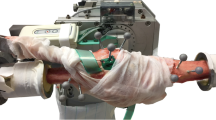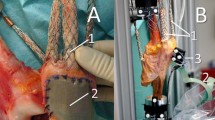Abstract
Purpose
The current literature suggests that kinematic total knee arthroplasty (kTKA) may be associated with better outcome scores in patients with constitutional varus alignment. The underlying patellofemoral kinematic changes (patella tilting and patella tracking) and patellofemoral pressure distribution have not yet been described. The present study compared the effects of different tibial cuts, as used in kTKA, on patellofemoral knee kinematics and the pressure distribution, in addition to comparisons with the natural constitutional varus knee.
Methods
Seven cadaveric knee joints with constitutional varus alignment were examined in the native state and after 0°, 3°, or 6° tibial cut cruciate-retaining (CR)-TKA using an established knee joint simulator. The effects on patella rotation/patella tilting, patellofemoral pressure, and patellofemoral length ratios (= patella tracking) were determined. In addition, the natural knee joint and different tibial cuts in CR-TKA were compared (Student’s t test).
Results
In the patellofemoral joint, 6° CR-TKA was associated with the greatest similarity with the natural constitutional varus knee. By contrast, knees subjected to 0° CR-TKA exhibited the largest deviations of patellar kinematics. The smallest difference compared with the natural knee joint concerning patella tilting was found for 6° CR-TKA (mean 0.4°, p < 0.001), and the largest difference was noted for 0° CR-TKA (mean 1.7°, p < 0.001). Concerning patellofemoral pressure, 6° CR-TKA resulted in outcomes most similar to the natural knee joint, featuring a mean difference of 3 MPa. The largest difference from the natural knee joint was identified for 0° CR-TKA, with an average difference of 8.1 MPa (p < 0.001; total mean 17.7 MPa). Meanwhile, 3° and 6° CR-TKA induced medialization of the patella, with the latter inducing the largest medialization value of 4.5 mm at 90° flexion.
Conclusions
The improved outcome parameters in kTKA described in the literature could be attributable to the similar kinematics of the patellofemoral joint relative to the normal state. The current study confirmed the similar kinematics between the native constitutional varus knee joint and knee joints subjected to 3° or 6° CR-TKA (patellofemoral rotation/patella tilting and patella pressure). Conversely, there was pronounced medialization of the patella following 6° CR-TKA. Patella pressure and patella tilting are described in the literature as possible causes of anterior knee pain after TKA, whereas medialization of the patella, which is also influenced by other causes, might play a subordinate role.
Level of evidence
V, Biomechanical study.









Similar content being viewed by others
References
Baker PN, Rushton S, Jameson SS, Reed M, Gregg P, Deehan DJ (2013) Patient satisfaction with total knee replacement cannot be predicted from pre-operative variables alone: a cohort study from the National Joint Registry for England and Wales. Bone Jt J 95-b:1359–1365
Bell SW, Young P, Drury C, Smith J, Anthony I, Jones B et al (2014) Component rotational alignment in unexplained painful primary total knee arthroplasty. Knee 21:272–277
Berend ME, Ritter MA, Meding JB, Faris PM, Keating EM, Redelman R et al (2004) The Chetranjan Ranawat Award: tibial component failure mechanisms in total knee arthroplasty. Clin Orthop Relat Res 428:26–34
Dlima DD, Chen PC, Colwell CW (2001) Polyethylene contact stresses, articular congruity, and knee alignment. Clin Orthop Relat Res 392:232–238
Fang DM, Ritter MA, Davis KE (2009) Coronal alignment in total knee arthroplasty: just how important is it? J Arthroplasty 24:39–43
Fuchs S, Skwara A, Tibesku CO, Rosenbaum D (2005) Retropatellar contact characteristics before and after total knee arthroplasty. Knee 12:9–12
Ghomrawi HM, Mancuso CA, Dunning A, Gonzalez Della Valle A, Alexiades M, Cornell C et al (2017) Do surgeon expectations predict clinically important improvements in WOMAC scores after THA and TKA? Clin Orthop Relat Res. https://doi.org/10.1007/s11999-017-5331-8
Hirschmann MT, Moser LB, Amsler F, Behrend H, Leclerq V, Hess S (2019) Functional knee phenotypes: a novel classification for phenotyping the coronal lower limb alignment based on the native alignment in young non-osteoarthritic patients. Knee Surg Sports Traumatol Arthrosc. https://doi.org/10.1007/s00167-019-05509-z
Hirschmann MT, Testa E, Amsler F, Friederich NF (2013) The unhappy total knee arthroplasty (TKA) patient: higher WOMAC and lower KSS in depressed patients prior and after TKA. Knee Surg Sports Traumatol Arthrosc 21:2405–2411
Hofmann AA, Tkach TK, Evanich CJ, Camargo MP, Zhang Y (1997) Patellar component medialization in total knee arthroplasty. J Arthroplasty 12:155–160
Howell SM, Howell SJ, Kuznik KT, Cohen J, Hull ML (2013) Does a kinematically aligned total knee arthroplasty restore function without failure regardless of alignment category? Clin Orthop Relat Res 471:1000–1007
Hungerford DS (1995) Alignment in total knee replacement. Instr Course Lect 44:455–468
Ishikawa M, Kuriyama S, Ito H, Furu M, Nakamura S, Matsuda S (2015) Kinematic alignment produces near-normal knee motion but increases contact stress after total knee arthroplasty: a case study on a single implant design. Knee 22:206–212
Lange T, Schmitt J, Kopkow C, Rataj E, Gunther KP, Lutzner J (2017) What do patients expect from total knee arthroplasty? A Delphi consensus study on patient treatment goals. J Arthroplasty 32:2093–2099.e2091
Leichtle UG, Wunschel M, Leichtle CI, Muller O, Kohler P, Wulker N et al (2014) Increased patellofemoral pressure after TKA: an in vitro study. Knee Surg Sports Traumatol Arthrosc 22:500–508
Lozano R, Campanelli V, Howell S, Hull M (2019) Kinematic alignment more closely restores the groove location and the sulcus angle of the native trochlea than mechanical alignment: implications for prosthetic design. Knee Surg Sports Traumatol Arthrosc 27:1504–1513
Magnussen RA, Weppe F, Demey G, Servien E, Lustig S (2011) Residual varus alignment does not compromise results of TKAs in patients with preoperative varus. Clin Orthop Relat Res 469:3443–3450
Matsuda S, Ishinishi T, White SE, Whiteside LA (1997) Patellofemoral joint after total knee arthroplasty. Effect on contact area and contact stress. J Arthroplasty 12:790–797
Matsuda S, Kawahara S, Okazaki K, Tashiro Y, Iwamoto Y (2013) Postoperative alignment and ROM affect patient satisfaction after TKA. Clin Orthop Relat Res 471:127–133
Matsumoto T, Takayama K, Ishida K, Hayashi S, Hashimoto S, Kuroda R (2017) Radiological and clinical comparison of kinematically versus mechanically aligned total knee arthroplasty. Bone Jt J 99-b:640–646
Morgan SS, Bonshahi A, Pradhan N, Gregory A, Gambhir A, Porter ML (2008) The influence of postoperative coronal alignment on revision surgery in total knee arthroplasty. Int Orthop 32:639–642
Murakami AM, Hash TW, Hepinstall MS, Lyman S, Nestor BJ, Potter HG (2012) MRI evaluation of rotational alignment and synovitis in patients with pain after total knee replacement. J Bone Jt Surg Br 94:1209–1215
Odum SM, Fehring TK (2016) Can original knee society scores be used to estimate new 2011 knee society scores? Clin Orthop Relat Res 475(1):160–167
Parratte S, Pagnano MW, Trousdale RT, Berry DJ (2010) Effect of postoperative mechanical axis alignment on the fifteen-year survival of modern, cemented total knee replacements. J Bone Jt Surg Am 92:2143–2149
Petersen W, Rembitzki IV, Bruggemann GP, Ellermann A, Best R, Koppenburg AG et al (2014) Anterior knee pain after total knee arthroplasty: a narrative review. Int Orthop 38:319–328
Ritter MA, Davis KE, Meding JB, Pierson JL, Berend ME, Malinzak RA (2011) The effect of alignment and BMI on failure of total knee replacement. J Bone Jt Surg Am 93:1588–1596
Ritter MA, Faris PM, Keating M, Meding JB (1994) Postoperative alignment of total knee replacement. Clin Orthop Relat Res 299:153–156
Riviere C, Iranpour F, Auvinet E, Howell S, Vendittoli PA, Cobb J et al (2017) Alignment options for total knee arthroplasty: a systematic review. Orthop Traumatol Surg Res 103:1047–1056
Slevin O, Hirschmann A, Schiapparelli FF, Amsler F, Huegli RW, Hirschmann MT (2018) Neutral alignment leads to higher knee society scores after total knee arthroplasty in preoperatively non-varus patients: a prospective clinical study using 3D-CT. Knee Surg Sports Traumatol Arthrosc 26:1602–1609
Steinbruck A, Fottner A, Schroder C, Woiczinski M, Schmitt-Sody M, Muller T et al (2017) Influence of mediolateral tibial baseplate position in TKA on knee kinematics and retropatellar pressure. Knee Surg Sports Traumatol Arthrosc 25:2602–2608
Steinbrück A, Schröder C, Woiczinski M, Fottner A, Müller PE, Jansson V (2013) Patellofemoral contact patterns before and after total knee arthroplasty: an in vitro measurement. Biomed Eng Online 12:58
Steinbruck A, Schroder C, Woiczinski M, Schmidutz F, Muller PE, Jansson V et al (2017) Mediolateral femoral component position in TKA significantly alters patella shift and femoral roll-back. Knee Surg Sports Traumatol Arthrosc 25:3561–3568
Tanikawa H, Tada M, Harato K, Okuma K, Nagura T (2017) Influence of total knee arthroplasty on patellar kinematics and patellofemoral pressure. J Arthroplasty 32:280–285
Theodore W, Twiggs J, Kolos E, Roe J, Fritsch B, Dickison D et al (2017) Variability in static alignment and kinematics for kinematically aligned TKA. Knee 24:733–744
Vanlommel L, Vanlommel J, Claes S, Bellemans J (2013) Slight undercorrection following total knee arthroplasty results in superior clinical outcomes in varus knees. Knee Surg Sports Traumatol Arthrosc 21:2325–2330
Victor J, Labey L, Wong P, Innocenti B, Bellemans J (2010) The influence of muscle load on tibiofemoral knee kinematics. J Orthop Res 28:419–428
Victor J, Van Glabbeek F, Vander Sloten J, Parizel PM, Somville J, Bellemans J (2009) An experimental model for kinematic analysis of the knee. J Bone Jt Surg Am 91(Suppl 6):150–163
Wilharm A, Hurschler C, Dermitas T, Bohnsack M (2013) Use of Tekscan K-scan sensors for retropatellar pressure measurement avoiding errors during implantation and the effects of shear forces on the measurement precision. Biomed Res Int 2013:829171
Woiczinski M, Kistler M, Schroder C, Braun C, Weber P, Muller PE et al (2019) TKA design-integrated trochlea groove rotation reduces patellofemoral pressure. Knee Surg Sports Traumatol Arthrosc 27:1680–1692
Worlicek M, Moser B, Maderbacher G, Zentner R, Zeman F, Grifka J et al (2017) The influence of varus and valgus deviation on patellar kinematics in healthy knees: an exploratory cadaver study. Knee 24:711–717
Young SW, Walker ML, Bayan A, Briant-Evans T, Pavlou P, Farrington B (2017) The Chitranjan S. Ranawat Award: no difference in 2-year functional outcomes using kinematic versus mechanical alignment in TKA: a randomized controlled clinical trial. Clin Orthop Relat Res 475:9–20
Funding
Funding was provided by Deutsche Arthrosehilfe e.V.
Author information
Authors and Affiliations
Contributions
FM: planning/conception of the study, collection of data, analysis and interpretation, statistical analysis, and writing and revising article; (orthopedic surgeon). HS: collection of data, analysis and interpretation, and statistical analysis (Dr. bio. hum.). SA and DL: interpretation of data and critical revision of the article (Dr. bio. hum.). BF: critical revision of the article (attending surgeon at HSS). RH: critical revision of the article, final approval of the article, and overall responsibility (surgeon in chief University of Ulm).
Corresponding author
Ethics declarations
Conflict of interest
We certify that we have not signed any agreement with commercial interest related to this study, which would, in any way, limit publication of any and all data generated for the study or to delay publication for any reason. Dr. Faschingbauer reports personal fees from Deutsche Arthrosehilfe e.V. during the conduct of the study.
Ethical review committee statement
The authors’ institutional review board approved this study.
Additional information
Publisher's Note
Springer Nature remains neutral with regard to jurisdictional claims in published maps and institutional affiliations.
Rights and permissions
About this article
Cite this article
Faschingbauer, M., Hacker, S., Seitz, A. et al. The tibial cut influences the patellofemoral knee kinematics and pressure distribution in total knee arthroplasty with constitutional varus alignment. Knee Surg Sports Traumatol Arthrosc 28, 3258–3269 (2020). https://doi.org/10.1007/s00167-019-05835-2
Received:
Accepted:
Published:
Issue Date:
DOI: https://doi.org/10.1007/s00167-019-05835-2




